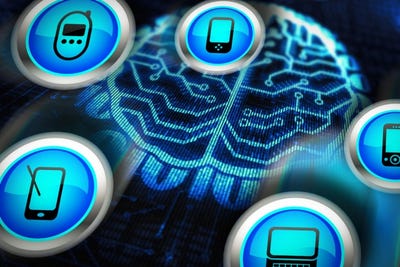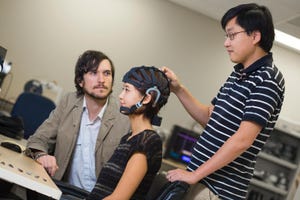The field of electronics continues to evolve at an exponential rate despite many pundits' declaration that Moore's law is dead. In any event, it is still certainly hard to keep up with all of the advances in the field of electronics. Here, we present an artificially intelligent mobile chip, dissolving implantable electronics, and a host of other advances.
Qmed Staff
1. A Mobile Chip with AI
 MIT researchers this week unveiled a new chip designed to enable mobile devices to implement "neural networks" modeled after the human brain. The chip, called "Eyeriss," was presented at the International Solid State Circuits Conference in San Francisco. It is 10 times as efficient as a mobile GPU, according to MIT. The idea is for mobile devices to be able to run artificial-intelligence algorithms locally, rather than uploading data to the Internet for processing. Internet of Things sensors could make use of Eyeriss, too.
MIT researchers this week unveiled a new chip designed to enable mobile devices to implement "neural networks" modeled after the human brain. The chip, called "Eyeriss," was presented at the International Solid State Circuits Conference in San Francisco. It is 10 times as efficient as a mobile GPU, according to MIT. The idea is for mobile devices to be able to run artificial-intelligence algorithms locally, rather than uploading data to the Internet for processing. Internet of Things sensors could make use of Eyeriss, too.
"You can imagine that if you can bring that functionality to your cell phone or embedded devices, you could still operate even if you don't have a Wi-Fi connection. You might also want to process locally for privacy reasons. Processing it on your phone also avoids any transmission latency, so that you can react much faster for certain applications," MIT electrical engineering and consumer science professor Vivienne Sze said in a news release.
2. Dissolving Implantable Electronics
Scientists at Washington University School of Medicine in St. Louis and the University of Illinois at Urbana-Champaign have developed wireless brain sensors that incorporate bioresorbable electronics and materials, according to Qmed's sister UBM media outlet Plastics Today. The sensors could allow for temporary monitoring of intracranial pressure and temperature, after which the sensors simply absorb into the body without the need for additional surgery. Researchers see potential to help traumatic brain injury patients, as well as to monitor activity in organ systems throughout the body.
"The benefit of these new devices is that they dissolve over time, so you don't have something in the body for a long time period, increasing the risk of infection, chronic inflammation and even erosion through the skin or the organ in which it's placed. Plus, using resorbable devices negates the need for surgery to retrieve them, which further lessens the risk of infection and further complications," said co-first author Rory K. J. Murphy, MD, a neurosurgery resident at Washington University School of Medicine and Barnes-Jewish Hospital in St. Louis.
3. Lithium Batteries That Won't Explode

Stanford University researchers have developed what they say is the first lithium-ion battery that shuts down before overheating. The battery then restarts immediately after the temperature cools. The Stanford researchers say the new technology could prevent battery fires that have plagued devices ranging from recliners and computers to navigation systems and hoverboards.
The battery is able to shut down thanks to a materials solution: spiky nickel particles coated with graphene and embedded in a thin film of elastic polyethylene. The elastic polyethylene stretches when exposed to heat, causing the spiky particles to spread apart and shutting the battery down; the particles come closer together again after the battery cools.
Learn more about cutting-edge medical devices at MD&M East, June 14-15, 2016 in New York City. |
4. Portable Brain EEG
 It wasn't long ago that EEG technology had a price point that was far out of the range of an average consumer.
It wasn't long ago that EEG technology had a price point that was far out of the range of an average consumer.
But in the past few years, a range of researchers have been endeavoring to put EEG technology in consumers' hands. The functionality of the first wave of devices may have been less than impressive, but it is steadily improving. Most recently, researchers at the University of California, San Diego (UCSD) have created an accurate dry portable EEG system that can be used to study neurological disorders and monitor brain activity. The device is different than traditional clinical EEG systems, which relied on dozens of electrodes to be affixed to the scalp in conjunction with a conductive gel. Cognionics, the name of the UCSD spinoff working on the project, has declared that its technology is just as accurate as traditional EEG. And unlike traditional EEG systems, Cogionics' technology can be comfortably used in the home. "This is going to take neuroimaging to the next level by deploying on a much larger scale," said Mike Yu Chi, a lead author, said in a statement. "You will be able to work in subjects' homes. You can put this on someone driving."
5. Easier-to-Produce Medical Sensors
Bioengineers at the University of California, San Diego, say they have been able to cut in half the time it takes to produce high-tech flexible sensors for medical applications. They're describing the advance as another step toward mass production of the sensors, which could be used to monitor everything from vital signs to brain activity.
The advance brings the sensors, which can be used to monitor vital signs and brain activity, one step closer to mass-market manufacturing. "A clinical need is what drove us to change our fabrication process," UCSD engineering professor Todd Coleman said in a news release.
The key to the new process was an elastomer coating about 20 to 50 µm thick. The silicon-like coating was able to remove the sensors, made of gold and chromium, from the silicon wafer without chemical solvents. The engineering for the coating proved tricky: the coating had been sticky enough so that researchers could build the sensors in the first place, but loose enough to allow the sensors to peel off the wafer.
6. Next Generation of Wi-Fi Has Twice the Range
 Wi-Fi is a commonly used wireless protocol in many hospitals and many newer medical devices rely on Wi-Fi that is used in both hospital and home settings. Now the Wi-Fi Alliance has announced that it will debut the 802.11ah wireless protocol, also known as Wi-Fi HaLow, which was designed with the Internet of Things in mind and may give Bluetooth a run for its money for some applications. One of the primary industries expected to benefit from the improved performance of Wi-Fi HaLow is digital healthcare, according to the Alliance. Rather than using the 2.4 or 5GHz bands, the new protocol will rely on the 900 MHz band. The new protocol could feasibly transmit a signal at least twice as much as standard Wi-Fi networks, which cover a range of roughly 100 meters. It can also penetrate solid objects such as walls more effectively than older Wi-Fi signals. Transmission speeds of WiFiHaLow, however, are less impressive, measuring in the tens of megabits per second, which is adequate for most IoT applications.
Wi-Fi is a commonly used wireless protocol in many hospitals and many newer medical devices rely on Wi-Fi that is used in both hospital and home settings. Now the Wi-Fi Alliance has announced that it will debut the 802.11ah wireless protocol, also known as Wi-Fi HaLow, which was designed with the Internet of Things in mind and may give Bluetooth a run for its money for some applications. One of the primary industries expected to benefit from the improved performance of Wi-Fi HaLow is digital healthcare, according to the Alliance. Rather than using the 2.4 or 5GHz bands, the new protocol will rely on the 900 MHz band. The new protocol could feasibly transmit a signal at least twice as much as standard Wi-Fi networks, which cover a range of roughly 100 meters. It can also penetrate solid objects such as walls more effectively than older Wi-Fi signals. Transmission speeds of WiFiHaLow, however, are less impressive, measuring in the tens of megabits per second, which is adequate for most IoT applications.
7. A Pressure Sensor for Detecting Tumors and Making Robots More Nimble
 A team of Japanese and U.S. scientists have developed pressure-sensitive gloves outfitted with pressure sensors that could assist with physical screening of breast cancer and other medical conditions as well as in boosting the dexterity of soft robots.
A team of Japanese and U.S. scientists have developed pressure-sensitive gloves outfitted with pressure sensors that could assist with physical screening of breast cancer and other medical conditions as well as in boosting the dexterity of soft robots.
The researchers had to develop a nanofiber-based pressure sensor to be able to measure pressure change when the sensors themselves are twisted and wrinkled. Two Japanese researchers, Sungwon Lee and Takao Someya from the University of Tokyo's Graduate School of Engineering, created a sensor that is about micrometers thick capable of measuring pressure in 144 separate locations.
The researchers report real-time (response time of ~20 ms), large-area, normal pressure monitoring under a variety of complex bending conditions.
8. "Tree" Energy Harvesters
Ohio State University researchers have demonstrated that tree-like structures made with electromechanical materials could be used to harvest energy from structural vibrations caused by wind, seismic activity, and movement. The "trees" themselves would be simple structures: a trunk with a few branches, and no leaves needed. Ohio State mechanical and aerospace engineering professor Ryan Harne envisions early applications including powering the sensors that monitor the structural integrity and health of civil infrastructure. But it isn't a stretch to think of potential applications in medical settings, either.
9. Meet the Tech Tat
A technology startup called Chaotic Moon is is boasting a "Tech Tat" that combines the aesthetics of traditional wearables with wearables functionality including tracking heart rate, blood pressure, body temperature, and more, reports Wired. Chaotic Moon's temporary tattoos employ electroconducive paint to help pick up body vital signs.
 10. Mouth Guard Sensor
10. Mouth Guard Sensor

Engineers at UCSD have built a mouth guard prototype. It can monitor health markers such as lactate, cortisol, and uric acid. The technology is designed to transmit health tracking information wirelessly in real time to any smartphone, laptop, or tablet device. Prospective users of the technology include athletes who look to monitor performance levels in real time, or pilots and soldiers looking to measure stress levels in the field.
It is novel for a sensor like this to sensor focus on uric acid, a valuable health marker that was previously only measurable when drawing blood from a patient.
Learn more about cutting-edge medical devices at MD&M East, June 14-15, 2016 in New York City. |
Chris Newmarker is senior editor of Qmed and MPMN. Follow him on Twitter at @newmarker.
Like what you're reading? Subscribe to our daily e-newsletter.
About the Author(s)
You May Also Like
